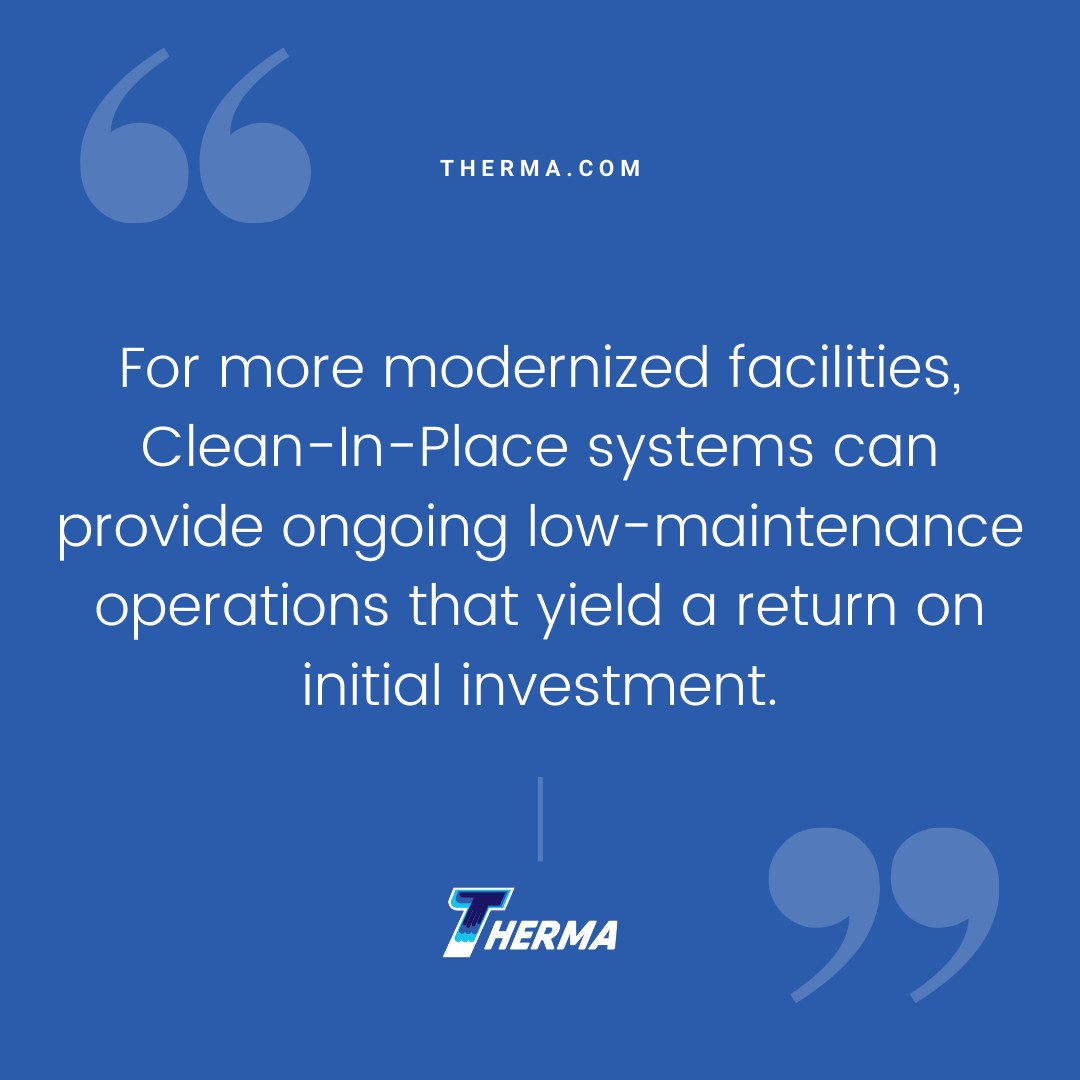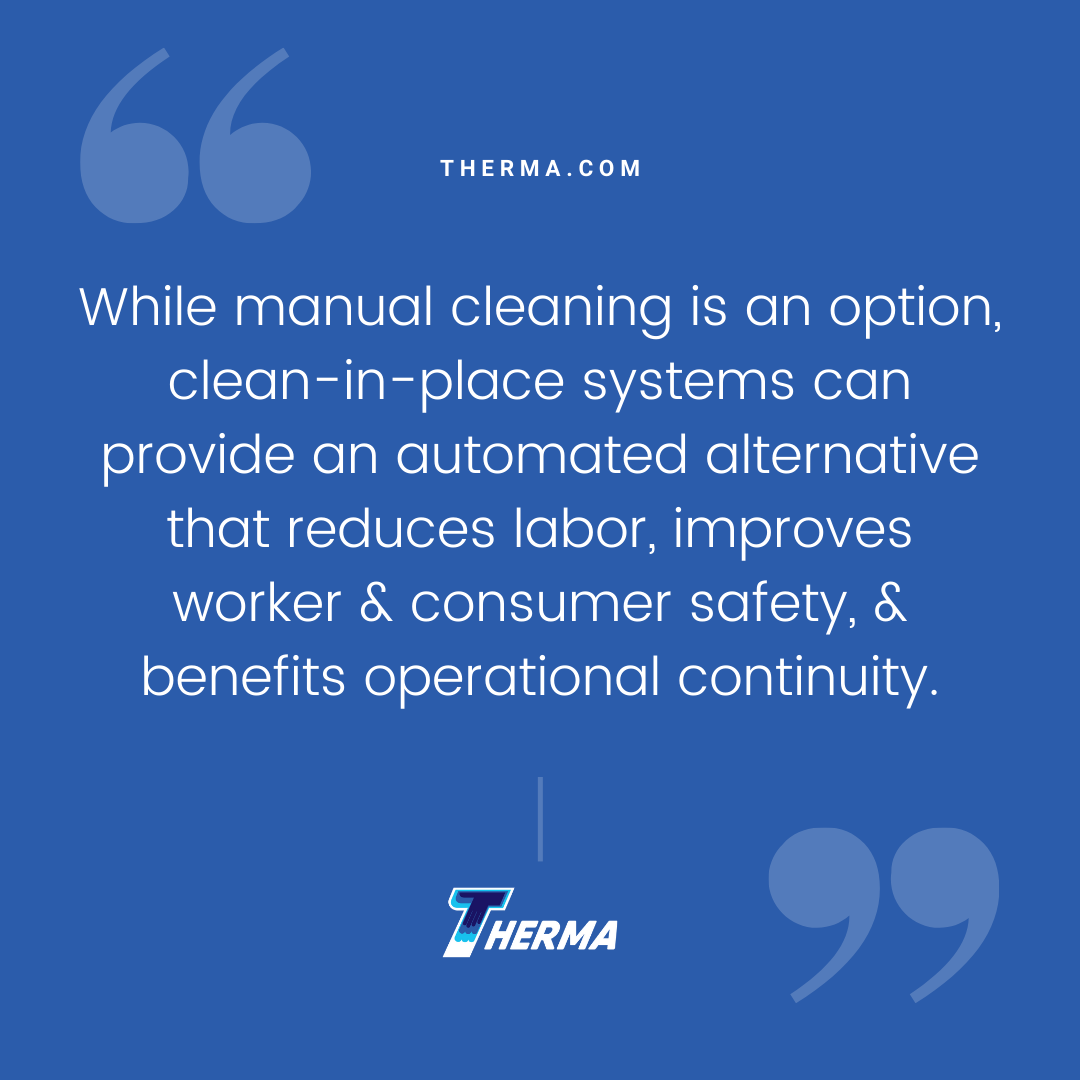by Ali Kriscenski
The manufacturing industry hosts a diverse range of businesses, from food to pharma, and all with their own specific process system requirements. Across business types, regulatory standards set strict guidelines for the level of frequency that must be maintained in the equipment that creates our food, beverages, and medications. While manual cleaning is an option, clean-in-place (CIP) systems can provide an automated alternative that reduces labor, improves worker and consumer safety, and benefits operational continuity. Here’s how:
What Are Clean In Place Systems?
Clean-in-place (CIP) systems help food-and-beverage, biopharmaceutical and other types of manufacturers stay at a high level of production. CIPs are automated, integrated systems that clean the interior surfaces of process equipment components without requiring any disassembly of the process. They can be designed and configured to meet the needs of your manufacturing process as well as any energy or water efficiency goals. They help ensure quality and safety while supporting manufacturing production goals.
Importance of CIP
Food and drug safety for consumers is dependent on the diligence of manufacturers to maintain clean operations, free from contaminants that may affect the safety or efficacy of consumer products. This is overseen by regulatory standards from the U.S. Food and Drug Administration (FDA) and other industry authorizing bodies. The FDA’s oversight is intended to protect consumers, and also to provide guidance to businesses to ensure best practices.
CIP systems provide a way for facilities to incorporate automated cleaning that meets industry requirements. CIPs also eliminate the need for personnel to complete cleaning requirements, creating lower labor costs and reducing workplace hazards. With the right system design, a CIP system can help increase productivity and streamline operations while providing compliance assurance.
CGMP and CIP
The US Food and Drug Administration (FDA) sets regulations for Current Good Manufacturing Practice (CGMP) to ensure product safety. These regulations are intended to protect consumers from contaminants and to regulate the consistency of medications. As drug processing systems can be complex, accuracy in maintaining high levels of system operation is crucial to meeting CGMP guidelines.
In order to maintain quality and safety, drug processing equipment must be kept in good condition. The maintenance and calibration of system components is essential to quality control. The process of disassembling piping, fittings or vessels to clean equipment can affect production and sensitive controls. CIP systems provide an automated solution that can be designed and maintained to meet specific processing requirements and ensure product quality.
CIP for Food and Beverage Facilities
The food-and-beverage industry also relies on complex processing equipment, and must meet FDA regulations for food safety. In the US, this industry includes a wide range of product suppliers and scales of production operations. From small startups to multinational brands, every facility depends on operational continuity, worker safety and product quality to maintain and grow its business.
While some food companies produce limited product lines, such as yogurt, others work to produce a wide range of end product types that may or may not use similar raw ingredients. In either instance, the condition of equipment can affect entire production lines if it is not maintained to meet food safety and quality standards.
Another factor in choosing a CIP system is worker safety. Aside from environmental conditions, like noise, workers in food processing facilities face occupational dangers from chemical or biological hazards, and from the equipment used in the food processing system. CIP systems provide a way for equipment to meet requirements without putting workers at risk.

Advantages and Considerations of CIP
The integration of a CIP system into production equipment brings the advantages of reduced cleaning time, consistency in cleaning, increased productivity and improved worker safety. These systems help simplify operations and, when designed correctly, can contribute to increased revenue.
One consideration in choosing a CIP system is the operating cost. As the facility manager, it’s important to consider how the system will affect energy and water use, costs of supplies (such as cleaning agents) and any additional processes needed for waste disposal. All of these are also considerations for manual equipment cleaning, so the increased efficiency of a CIP system will likely improve operations.
Smaller manufacturing facilities, such as artisanal or craft food and beverage makers, use time-tested equipment that may not need automated cleaning. The types of processing equipment, materials or configurations may require thorough manual cleaning processes. These types of production facilities could also be focused on premium, small-batch products, with less emphasis on high production.
CIP with Therma
For more modernized facilities, CIP systems can provide ongoing low-maintenance operations that yield a return on initial investment. The best approach is to engage the help of system design specialists like Therma who can help identify when and where a CIP system will add value to production and build efficiencies. With the optimal design and settings, a CIP system can significantly improve energy savings and reduce downtime. Contact us today!
Ali Kriscenski was trained in high-performance building design at Boston Architectural College. She has worked with leading architecture and construction firms in NYC and New England and served on the executive team at the Forest Stewardship Council International. She was the managing editor at Inhabitat and has worked pro bono for the Green Building Institute, ISEAL Alliance and Habitat for Humanity.
Sources
Sani Matic – Food & Beverage: Clean-In-Place (CIP) Systems
Water Quality Products – Improving Clean-in-Place Technology
Markets and Markets – Clean-in-Place Market Forecast








